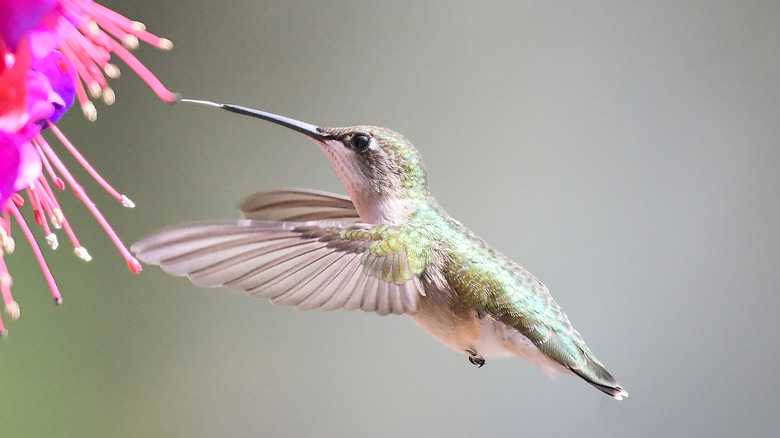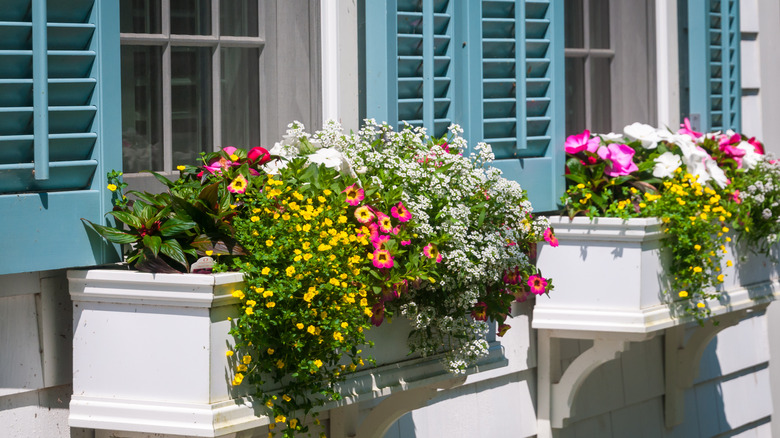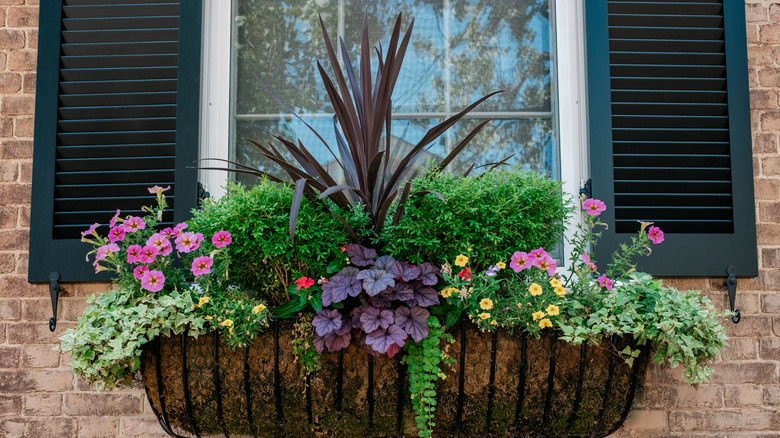Create A Miniature Garden For Hummingbirds With These Window Box Flowers
We may receive a commission on purchases made from links.
Are you trying to attract hummingbirds to your home but lack the yard space to grow their beloved plants? Believe it or not, you can still invite these tiny feathered creatures for a delicious nectar meal without an outdoor garden. All you need to do is create a flower box garden, fill it with the right plants, and hummingbirds will flock to your windows — right where you can easily watch them. Salvia, fuchsia, petunias, and lantanas are plants that hummingbirds absolutely love. What's more, all of them can grow in containers, so they make excellent flowering plants for your window boxes.
Now, creating a window box garden for these plants comes with a few specific demands. For one, the boxes you choose must fit in with the design of your home's exterior. You also need to fasten them properly to the wall to keep them from breaking off and falling when weighed down by the moist potting mix inside. Crucially, flower box flowers require a bit of special care, since they're particularly exposed to the elements and don't have as much substrate to hold water for them or sink their roots into. Below, you'll find out how to choose, fasten, and fill window boxes with a potting mix, and learn the best practices for keeping the flowers inside them happy and appealing to hummingbirds throughout the summer.
How to set up the hummingbird window box
Your first task is to find window boxes that will fit your window openings properly. Start by determining the correct window box length and means of fastening. If your home has exterior shutters, it's common practice to have the window boxes overlap the shutters a bit on either side. The overlap dimensions are up to you, but the box should be longer than the window opening by several inches. If your home has no shutters but there is exterior window casing, make sure they extend to the outer edge of the trim on either side, as that's where you'll mount the boxes to the wall studs. If there's no exterior window casing, simply measure the length of the window opening — that's how long you want the boxes to be.
Next, you need to install the boxes. You can do this by bolting them directly to the wall or by using brackets like these ones from The Home Depot. In either situation, you'll need to ensure proper support for the weight of the box by drilling the screws into the studs. If your home has a brick exterior design, you'll need to use masonry anchors like these ones sold at Lowe's to ensure that the screws are securely fastened. With the boxes installed, fill the box halfway with a potting mix that promotes good drainage and aeration. Finally, plant the flowers, leaving at least 2 inches of space between them.
Ongoing care for window box flowers
You can count on the growing medium inside the window boxes to dry out quickly, especially on hot, sunny days. This tendency to dry out and overheat means you'll need to water the window box flowers frequently — sometimes daily. And if you notice that the plants soak up the water and the soil is dry to the depth of an inch shortly after watering, you may need to irrigate more than once on the same day. When you irrigate, make sure you're giving the plants a good soaking to the point where water drips through the drainage holes. Unfortunately, watering the plants with such frequency removes nutrients from the growing medium. To make sure your plants still get the nutrition they need, add slow-release fertilizer pellets to the mix (the mix must be moist when you add the plant food).
Hummingbird favorites like petunias, fuchsias, lantanas, or bee balm can grow vigorously in their window box. To keep them from assuming an unruly appearance, you should prune them as needed. Deadheading will also encourage the flowers to keep blooming, so they can attract hummingbird visitors to your home throughout the season. If your region is prone to sudden temperature drops during summer, you'll need to come up with a way to cover the flower boxes and protect the flowers.


